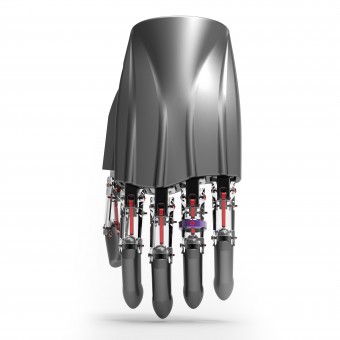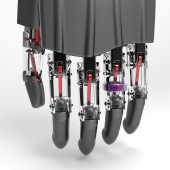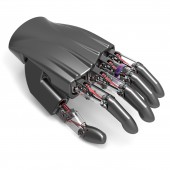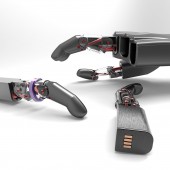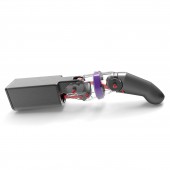DESIGN NAME:
Embrace
PRIMARY FUNCTION:
Myoelectric Prosthetic Hand
INSPIRATION:
There are 11.4 million people with hand amputations in the world, 80% of which come from developing countries. We are developing advanced, neutrally controlled prosthetic limbs, the first with sensory feedback, that can be produced for less than $1000. Patients who wear prosthetic hand typically have stigma and are emotionally unstable. When patient receive a new prosthetic hand, the patient will receive a ring that will fit in the fourth finger from the prosthetic hand. The patient will have significant emotional connection with the prosthetic hand.
UNIQUE PROPERTIES / PROJECT DESCRIPTION:
All parts were designed to be put together in two piece assemblies. Only one part would
need to be attached at a time during assembly. This avoided complex processes requiring two hands. A four-bar linkage was used as a finger joint coupling mechanism to produce consistent movement and greater force at the fingertip than a purely tendon-based design. These design choices were made at the expense of durability and efficiency due to the lack of non-backdriveable gearing, higher-strength components, and precision parts.
OPERATION / FLOW / INTERACTION:
Upon wearing the device, users undergo a minute long training procedure that trains the microchip in the hand to recognize muscle signals from sensors placed on the user forearm. Once the hand associates the muscle signals with particular grasps, the user can just make the same muscle movements to control the hand to open, close, fine pinch, make a 3 finger grasp, or rest. The elegant, anthropomorphic design of the hand will increase user acceptance while maintaining high functionality.
PROJECT DURATION AND LOCATION:
The project started in November 2013 in Champaign-Urbana, IL and is currently ongoing.
|
PRODUCTION / REALIZATION TECHNOLOGY:
The design of the hand incorporates five linear actuators and a servo to enable six degree-of-freedom articulation. Each digit of the hand can flex/extend, and the thumb additionally has the ability to oppose. The hand attaches to a socket which overlies the residual limb of the person with a transradial amputation. Electrodes embedded in the socket read muscle signals, which a machine learning algorithm decodes to actuate various grips in the hand, including hand open, close, fine pinch, 3 finger grasp, and rest.
SPECIFICATIONS / TECHNICAL PROPERTIES:
Height 260mm X Width 105mm X Depth 25mm
TAGS:
myoelectric, prosthetic hand, bionic, emotional connection, ring
RESEARCH ABSTRACT:
People with transradial amputations who live in economically disadvantaged communities need a prosthetic hand that is not only functional but also affordable, easy to manufacture, and simple to maintain. We developed an anthropomorphic, myoelectric prosthetic hand that was designed for use by people with transradial amputations in developing countries. This hand matches or exceeds the performance of other state of the art myoelectric prosthetic hands, but costs two orders of magnitude less and is easy to manufacture with a 3D printer and off the shelf parts.
CHALLENGE:
It is a challenge to incorporate six actuators in a prosthetic hand while maintaining an anthropomorphic form factor. In choosing the actuators, we had to find motors that were small, light-weight, energy-efficient, and produced enough torque. We also wanted to make the device able to be 3D-printed and produced at a low-cost, so that it could be affordable in developing nations.
ADDED DATE:
2015-03-01 09:44:31
TEAM MEMBERS (4) :
Cliff Shin, Timothy Bretl, Aadeel Akhtar and Patrick Slade
IMAGE CREDITS:
Cliff Shin, 2014.
|



